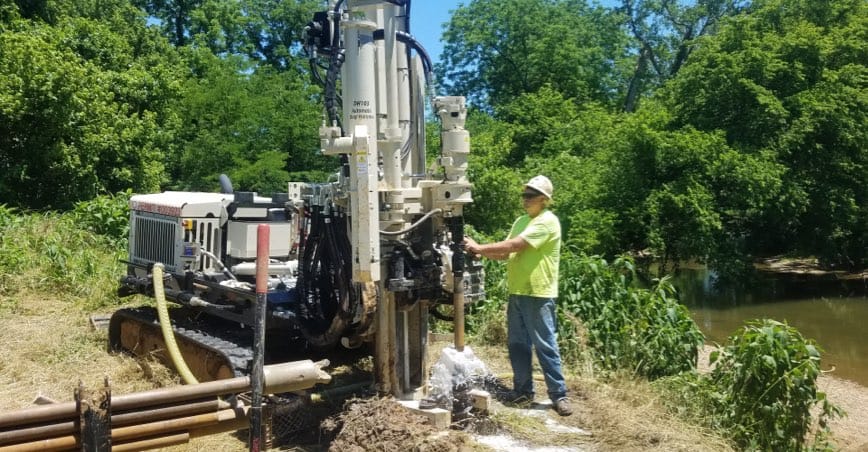Geotechnical Services
Your Local Geotechnical Services Firm
Smith & Co. Engineers is an employee-owned engineering firm offering a full-range of geotechnical services, from complete civil, environmental, and sanitary services and environmental permitting to subsurface geotechnical engineering and exploration.
We own and operate a certified laboratory for testing materials such as concrete, asphalt, aggregate, and soil. Our registered geologists and scientists provide geotechnical and foundation design and can sample material with our rubber tire drill rig and compact tracked rig.
Our FOcus
Our Geotechnical Services
We operate two exploration drill rigs with calibrated drive hammers for geotechnical investigations. Our drillers provide full-service drilling and are trained and experienced in many drilling techniques, such as those required for liquefaction evaluation. Our staff is experienced in conducting field work for site-specific seismic hazard assessments, such as those specified by the International Building Code.
A Variety of Drilling Methods
Geotechnical explorations are conducted primarily with our CME-750 all-terrain drill rig and our new Geoprobe 7822DT.
GEOPROBE 7822DT:
All-Terrain, Tracked Vehicle
Boring and Sampling to 250’
Compact: 11’-1” Length and 5’-10” Width
SPT with 140-lb calibrated auto hammer
CME-750:
All-Terrain, 4X4 Vehicle
Boring and Sampling to 500’
Length: 24’ Width: 7’-9”
SPT with calibrated auto hammer
Types and Methods:
- Auger
- Direct Push
- Environmental Soil Sampling
- Rotary
- Angle Drilling
- Mineral Sampling
- Core
- Compact Space
- Foundation Investigation
- Drilling for Liquefaction Analyses
- SPT with optional drop hammer

Geotechnical Exploration
Geotechnical exploration is a group of all explorations and investigations that are conducted in order to determine conditions in soil, rock, and underground water. Engineers and geologists examine the physical properties of subsurface materials for proposed structures and environmental concerns. The information gained from the investigation is necessary for successful long-term projects.
- Site Characterization
- Groundwater and Soil Contamination Assessment
- Rock and Soil Sampling
- In-situ Testing
- Soil profiling
- Structural Foundation Assessment
- Aquifer Testing
- Retaining Walls
- Contaminated and noncontaminated sites
- Landslide Assessment
- Material Evaluation
- Groundwater Monitoring
- Monitoring well installation & decommissioning
- Probing (Fill or Debris Area Determination)
- Rock Probes
- Rock Coring (Conventional or Wireline)
- Mud Rotary, Hollow-Stem, and Continuous Flight
- Split Spoon
- Shelby Tube
- Continuous Sampling
- Well and Piezometer Installation

Bridges
Bridges require geotechnical investigation to ensure settlement does not occur. Different foundations can be used based on the subsurface material type and condition. Rock Sockets, Shell Pile, and H-Pile are used primarily in bridge construction.

Buildings
Many large buildings benefit from geotechnical information provided by engineers and geologists. The information canpredict differential settlement and the design can be modified to address the variations in surface and subsurface material.

Specialty Structures
There are many structures that require holding grain, water, or heavy equipment that benefit from geotechnical, study. Some structures are uniquely shaped with weight parameters that rely heavily on knowing the existing soil and subsurface conditions.
Types of structures include:
Water Tanks, Large Storage Silos, Generators

Groundwater monitoring wells and pore water pressure (piezometer)
Groundwater monitoring wells are typically used for observing groundwater levels and flow conditions, obtaining samples for water quality, and for evaluating hydraulic properties. The position of the groundwater table and flow-through seepage influence the pressure of trapped water in the voids of a saturated soil. Understanding the pore water pressure is important when considering construction projects, trenching, or moving saturated soil.
A Variety of Drilling Methods
Geotechnical explorations are conducted primarily with our CME-750 all-terrain drill rig and our new Geoprobe 7822DT.
GEOPROBE 7822DT:
All-Terrain, Tracked Vehicle
Boring and Sampling to 250’
Compact: 11’-1” Length and 5’-10” Width
SPT with 140-lb calibrated auto hammer
CME-750:
All-Terrain, 4X4 Vehicle
Boring and Sampling to 500’
Length: 24’ Width: 7’-9”
SPT with calibrated auto hammer
Types and Methods:
- Auger
- Direct Push
- Environmental Soil Sampling
- Rotary
- Angle Drilling
- Mineral Sampling
- Core
- Compact Space
- Foundation Investigation
- Drilling for Liquefaction Analyses
- SPT with optional drop hammer

Geotechnical Exploration
Geotechnical exploration is a group of all explorations and investigations that are conducted in order to determine conditions in soil, rock, and underground water. Engineers and geologists examine the physical properties of subsurface materials for proposed structures and environmental concerns. The information gained from the investigation is necessary for successful long-term projects.
- Site Characterization
- Groundwater and Soil Contamination Assessment
- Rock and Soil Sampling
- In-situ Testing
- Soil profiling
- Structural Foundation Assessment
- Aquifer Testing
- Retaining Walls
- Contaminated and noncontaminated sites
- Landslide Assessment
- Material Evaluation
- Groundwater Monitoring
- Monitoring well installation & decommissioning
- Probing (Fill or Debris Area Determination)
- Rock Probes
- Rock Coring (Conventional or Wireline)
- Mud Rotary, Hollow-Stem, and Continuous Flight
- Split Spoon
- Shelby Tube
- Continuous Sampling
- Well and Piezometer Installation

Bridges
Bridges require geotechnical investigation to ensure settlement does not occur. Different foundations can be used based on the subsurface material type and condition. Rock Sockets, Shell Pile, and H-Pile are used primarily in bridge construction.

Buildings
Many large buildings benefit from geotechnical information provided by engineers and geologists. The information canpredict differential settlement and the design can be modified to address the variations in surface and subsurface material.

Specialty Structures
There are many structures that require holding grain, water, or heavy equipment that benefit from geotechnical, study. Some structures are uniquely shaped with weight parameters that rely heavily on knowing the existing soil and subsurface conditions.
Types of structures include:
Water Tanks, Large Storage Silos, Generators

Groundwater monitoring wells and pore water pressure (piezometer)
Groundwater monitoring wells are typically used for observing groundwater levels and flow conditions, obtaining samples for water quality, and for evaluating hydraulic properties. The position of the groundwater table and flow-through seepage influence the pressure of trapped water in the voids of a saturated soil. Understanding the pore water pressure is important when considering construction projects, trenching, or moving saturated soil.






